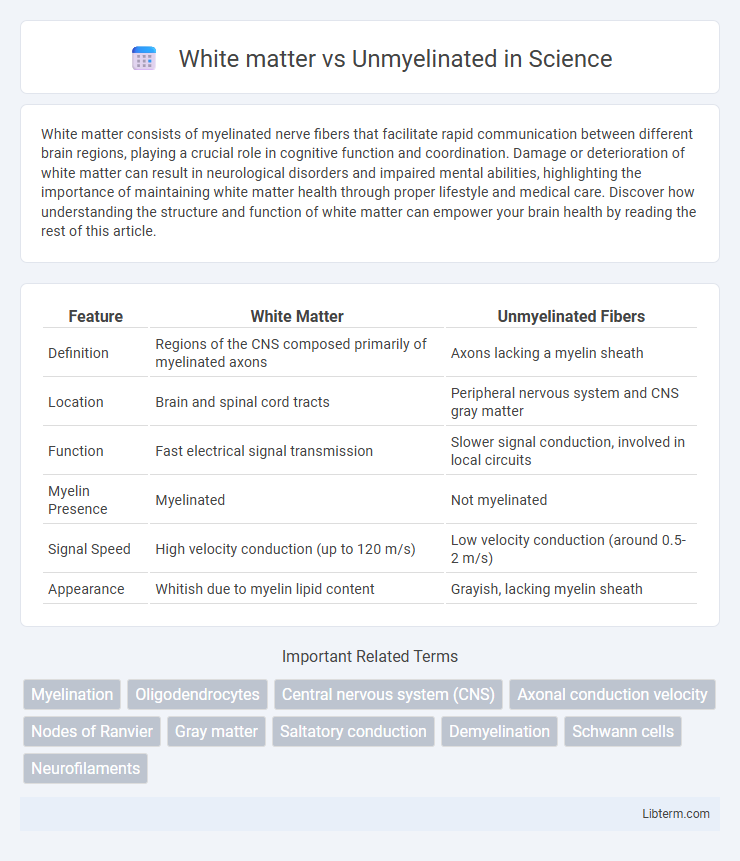White matter consists of myelinated nerve fibers that facilitate rapid communication between different brain regions, playing a crucial role in cognitive function and coordination. Damage or deterioration of white matter can result in neurological disorders and impaired mental abilities, highlighting the importance of maintaining white matter health through proper lifestyle and medical care. Discover how understanding the structure and function of white matter can empower your brain health by reading the rest of this article.
Table of Comparison
| Feature | White Matter | Unmyelinated Fibers |
|---|---|---|
| Definition | Regions of the CNS composed primarily of myelinated axons | Axons lacking a myelin sheath |
| Location | Brain and spinal cord tracts | Peripheral nervous system and CNS gray matter |
| Function | Fast electrical signal transmission | Slower signal conduction, involved in local circuits |
| Myelin Presence | Myelinated | Not myelinated |
| Signal Speed | High velocity conduction (up to 120 m/s) | Low velocity conduction (around 0.5-2 m/s) |
| Appearance | Whitish due to myelin lipid content | Grayish, lacking myelin sheath |
Introduction to White Matter and Unmyelinated Fibers
White matter consists primarily of myelinated axons that facilitate rapid electrical signal transmission across different brain regions, enhancing neural communication efficiency. Unmyelinated fibers lack the myelin sheath, resulting in slower conduction speeds but are crucial for functions requiring sustained signal transmission. The distinction between white matter and unmyelinated fibers lies in their structural composition and their roles in the nervous system's overall connectivity and processing speed.
Structural Differences: Myelinated vs Unmyelinated Neurons
White matter primarily consists of myelinated neurons, where axons are coated with a lipid-rich myelin sheath that facilitates rapid electrical signal transmission by enabling saltatory conduction. Unmyelinated neurons lack this myelin covering, resulting in slower signal propagation due to continuous conduction along the axon. Structurally, the presence of myelin in white matter increases axonal insulation and efficiency, distinguishing it from the grey matter's predominantly unmyelinated neuronal fibers.
Functions of White Matter in the Nervous System
White matter, composed primarily of myelinated axons, facilitates rapid communication between different brain regions by efficiently transmitting electrical signals. This myelination enhances signal speed and coordination, supporting complex functions such as motor control, sensory perception, and cognitive processing. In contrast, unmyelinated fibers transmit signals more slowly, primarily involved in pain and temperature sensation where rapid response is less critical.
Role and Significance of Unmyelinated Nerve Fibers
Unmyelinated nerve fibers play a crucial role in transmitting slow, diffuse signals essential for autonomic functions and pain perception. Unlike white matter, which consists primarily of myelinated axons enabling rapid signal conduction, unmyelinated fibers facilitate sustained communication in peripheral and central nervous systems. Their significance lies in modulating visceral responses and maintaining homeostasis through slower but continuous neural transmission.
Myelin Sheath: Composition and Purpose
The myelin sheath is composed primarily of lipids, especially cholesterol and sphingolipids, along with proteins like myelin basic protein, which insulates axons in white matter to facilitate rapid electrical signal transmission. White matter consists largely of myelinated axons, enhancing the speed and efficiency of neural communication across different brain regions. In contrast, unmyelinated fibers lack this lipid-rich sheath, resulting in slower signal conduction and primarily supporting local or less time-sensitive neural processes.
Signal Transmission: Speed and Efficiency Comparison
White matter consists primarily of myelinated axons, which enable rapid and efficient signal transmission through saltatory conduction, significantly increasing conduction velocity compared to unmyelinated fibers. Unmyelinated axons transmit signals more slowly and with less efficiency due to continuous propagation, resulting in delayed neural communication and higher energy consumption. The presence of myelin in white matter optimizes neural circuit performance by reducing latency and enhancing synchrony within complex brain networks.
Distribution in the Central and Peripheral Nervous Systems
White matter consists mainly of myelinated axons that facilitate rapid signal transmission and is predominantly found in the central nervous system (CNS), especially in the brain's deep regions and the spinal cord. Unmyelinated fibers, which conduct impulses more slowly, are distributed throughout both the CNS and the peripheral nervous system (PNS), where they are abundant in autonomic nerves and certain sensory pathways. The peripheral nervous system contains both myelinated and unmyelinated axons, with unmyelinated fibers forming the bulk of postganglionic autonomic nerves and small sensory C fibers.
White Matter Disorders vs Unmyelinated Fiber Pathologies
White matter disorders primarily involve damage or degeneration of myelinated nerve fibers, leading to impaired signal transmission in the central nervous system, as seen in conditions like multiple sclerosis and leukodystrophies. Unmyelinated fiber pathologies affect non-myelinated nerve fibers, typically impacting peripheral nervous system functions, resulting in symptoms related to sensory and autonomic dysfunctions. Understanding the distinction between white matter disorders and unmyelinated fiber pathologies is crucial for accurate diagnosis and treatment strategies targeting demyelination versus axonal degeneration.
Evolutionary and Developmental Perspectives
White matter, primarily composed of myelinated axons, enhances rapid and efficient neural communication crucial for complex brain functions and evolved significantly in vertebrates to support increased cognitive abilities. Unmyelinated fibers, common in simpler or earlier-evolving nervous systems, reflect an ancestral state of slower signal transmission suited for basic reflexes and local processing. Throughout development, myelination progresses postnatally, optimizing neural circuits and enabling advanced motor skills, sensory processing, and higher-order cognition in humans.
Clinical Implications and Future Research Directions
White matter, composed primarily of myelinated axons, facilitates rapid signal transmission and is crucial in neurodegenerative disorders such as multiple sclerosis, where demyelination disrupts neural communication. Unmyelinated fibers, although slower in conduction, are vital in pain and temperature sensation pathways, with their dysfunction implicated in peripheral neuropathies and chronic pain syndromes. Future research aims to develop targeted remyelination therapies and explore the plasticity of unmyelinated fibers to enhance neural repair and functional recovery in clinical settings.
White matter Infographic

 libterm.com
libterm.com